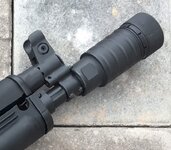Silver Vendor
- Messages
- 2,877
- Reactions
- 7,917
I have been researching the residual effects of gunfire in general, as my wife swears I have selective hearing...but then I've been on the range now for close to 30 years. The research was not only about the obvious; hearing, but inner ear organ damage as well...that being the spiral cavity of the inner ear containing sensory organs which produce nerve impulses in response to sound vibrations.
This came about the week before Christmas where I was co-teaching a group of LE folks. One student had a brake that would not only just about make a person's knees buckle, but physically pick them up and move them 5 yards with every shot. OK, maybe not 5 yards, but you get the picture.
In discussing the issue with some hearing specialists, doubling up on hearing protection with both ear plugs and muffs may not be enough. The concussion alone can cause symptoms of traumatic brain injury if exposed for long periods and/or consistent exposure.
With that in mind, I have made a decision about about muzzle brakes at not only the Cerberus Training Group facility, but anywhere I instruct. I know this may cause some to bypass training with my company, but feel it best for the long term health and safety concerns of my students, as well as the distraction they create in providing a positive learning environment.
Muzzle Brakes : Due to the possible long term residual effects of their use, from not only the decibel level, but also from the concussion which can lead to possible damage of the inner ear containing an organ which produces nerve impulses in response to sound vibrations, we are no longer allowing them on the range.
If you remove your brake prior to arriving at our facility, I have standard flash hiders to use at no cost to you. Let me know ahead of time.
This came about the week before Christmas where I was co-teaching a group of LE folks. One student had a brake that would not only just about make a person's knees buckle, but physically pick them up and move them 5 yards with every shot. OK, maybe not 5 yards, but you get the picture.
In discussing the issue with some hearing specialists, doubling up on hearing protection with both ear plugs and muffs may not be enough. The concussion alone can cause symptoms of traumatic brain injury if exposed for long periods and/or consistent exposure.
With that in mind, I have made a decision about about muzzle brakes at not only the Cerberus Training Group facility, but anywhere I instruct. I know this may cause some to bypass training with my company, but feel it best for the long term health and safety concerns of my students, as well as the distraction they create in providing a positive learning environment.
Muzzle Brakes : Due to the possible long term residual effects of their use, from not only the decibel level, but also from the concussion which can lead to possible damage of the inner ear containing an organ which produces nerve impulses in response to sound vibrations, we are no longer allowing them on the range.
If you remove your brake prior to arriving at our facility, I have standard flash hiders to use at no cost to you. Let me know ahead of time.







 I'm good for this next weekend's class, my 1911 does not have any race gun fanciness.
I'm good for this next weekend's class, my 1911 does not have any race gun fanciness.




